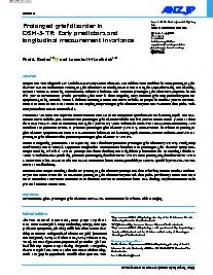Prolonged grief disorder in DSM-5-TR : Early predictors and longitudinal measurement invariance
Objective: The Diagnostic and Statistical Manual of Mental Disorders, 5th Edition, Text Revision includes prolonged grief disorder as a novel disorder. Prolonged grief disorder can be diagnosed when acute grief stays distressing and disabling, beyond 12 months following bereavement. Evidence indicates that elevated prolonged grief disorder symptoms in the first year of bereavement predict pervasive grief later in time; targeting early elevated grief may potentially prevent symptoms getting chronic. There is limited knowledge about the characteristics of people in the first year of bereavement who have an elevated chance of developing full prolonged grief disorder beyond the 12-month time point. This study examined these characteristics.
Methods: We used self-reported data from 306 adults who all completed questions on socio-demographic and lossrelated characteristics plus a measure of prolonged grief disorder within the first year of bereavement (Wave 1; time since loss: M = 4.97, SD = 3.13 months) and again 1 year later (Wave 2; time since loss: M = 17.84, SD = 3.38 months). We examined the prevalence rates of probable prolonged grief disorder (Wave 2), measurement invariance of prolonged grief disorder symptoms between waves, and associations of socio-demographic and loss-related variables, and Wave 1 prolonged grief disorder with probable prolonged grief disorder at Wave 2.
Results: Regarding prevalence, 10.1% (n = 31) met criteria for probable prolonged grief disorder (Wave 2). Multigroup confirmatory factor analysis supported longitudinal measurement invariance of prolonged grief disorder symptoms. People meeting criteria at Wave 1 (except the time criterion) had a significantly increased risk of meeting criteria at Wave 2. Variables best predicting probable prolonged grief disorder at Wave 2 were prolonged grief disorder at Wave 1, lower education, loss of a child and loss to unnatural/violent causes (sensitivity = 56.67%, specificity = 98.12%, 93.92% correct classifications).
Conclusion: People meeting criteria for prolonged grief disorder (except the time criterion) before the first anniversary of the death are at risk of full-blown prolonged grief disorder beyond this time point, particularly those who have lower education, confronted the death of a child and confronted unnatural/violent loss. Findings may inform advances in preventive bereavement care.
In: Australian & New Zealand Journal of Psychiatry ; ISSN: 0004-8674 | 56 | 6 | June | 667-674
https://journals.sagepub.com/doi/10.1177/00048674211025728


